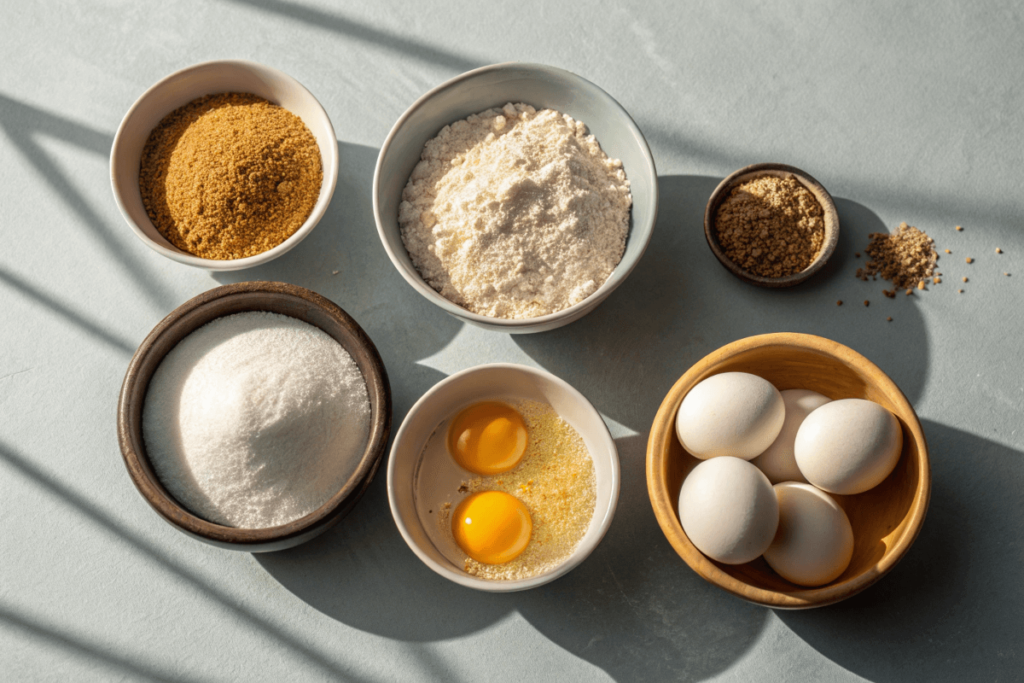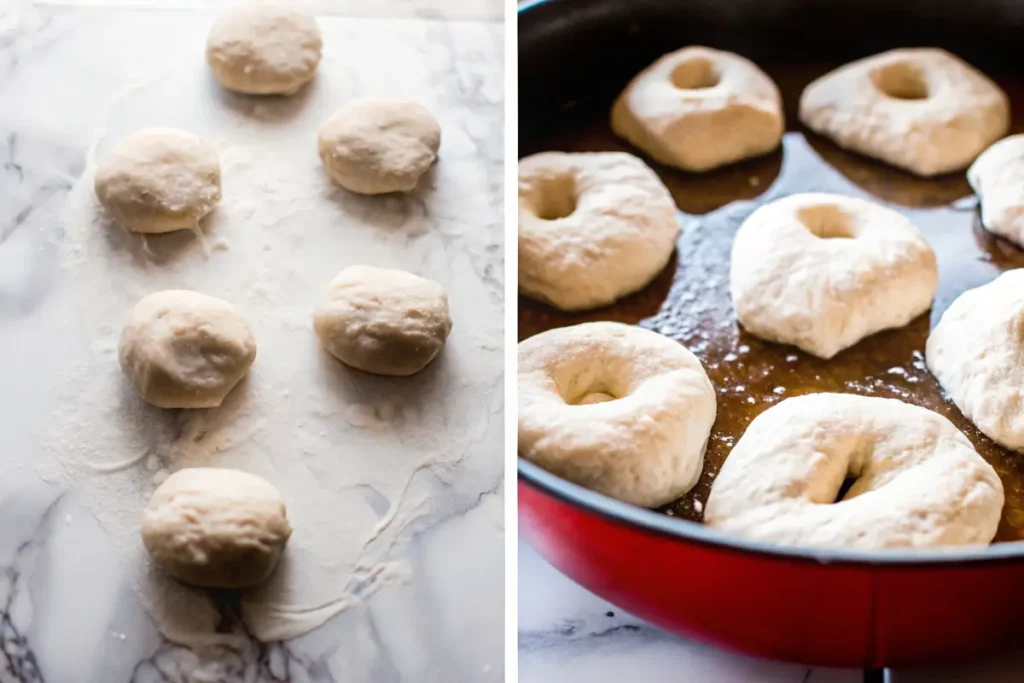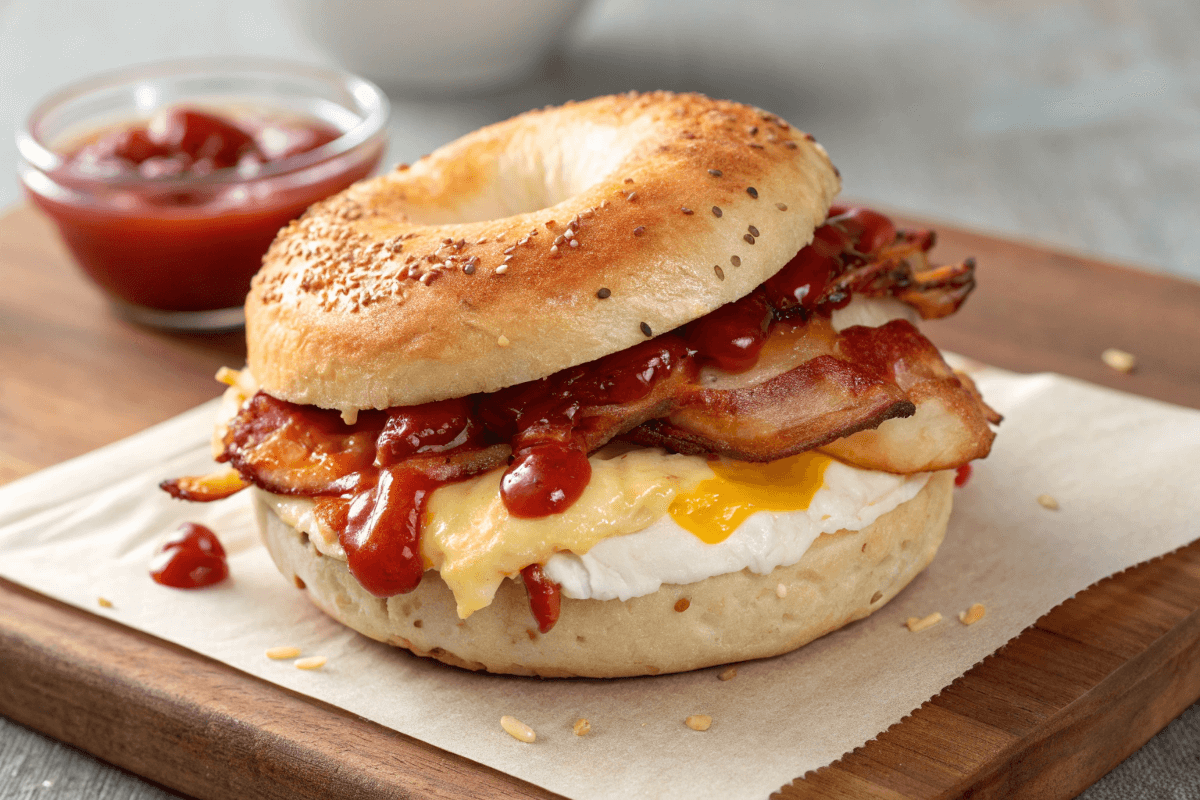Imagine waking up to the warm, comforting aroma of freshly baked egg bagels. For 11 years, home bakers have perfected this incredible egg bagel recipe. It turns an ordinary morning into a culinary adventure. Your journey to creating the most delicious homemade bagel with egg starts right here.

New York-style bagels have always been a breakfast favorite. But making them at home might seem intimidating. Fear not! The Best Egg Bagel Recipe breaks down the process into simple, manageable steps. Even novice bakers can master it. With just two hours of your time, you can create bagels that rival any professional bakery.
Why settle for store-bought when you can craft your own perfect egg bagels? The magic lies in understanding the technique. From activating the yeast at the precise temperature of 105-115ºF to achieving that signature chewy texture. Your kitchen will become a bagel-making sanctuary, filled with the promise of breakfast perfection.
Each batch of this homemade bagel with egg represents more than just a recipe. It’s a celebration of culinary skill, a moment of personal accomplishment. It transforms simple ingredients into something extraordinary. Get ready to embark on a delicious journey that will impress your family and elevate your breakfast game.
Understanding the Art of Homemade Egg Bagels
Making a traditional egg bagel is more than baking. It’s an art that brings the real New York bakery feel to your kitchen. It connects you to baking traditions and lets you enjoy fresh, tasty bread made by you.
What Makes New York-Style Egg Bagels Special
New York-style egg bagels are special for a few reasons:
- Rich, golden color from egg yolks
- Dense and chewy texture
- Distinctive slightly sweet flavor
- Glossy, crisp exterior
Benefits of Making Bagels at Home
There are many benefits to making your own egg bagel:
- Complete control over ingredients
- Fresh taste and texture
- Cost-effective compared to bakery prices
- Customizable flavor profiles
Key Characteristics of Perfect Egg Bagels
The perfect easy egg bagel has:
- Texture: Firm yet tender interior
- Crust: Shiny and golden brown
- Flavor: Rich with subtle egg notes
- Shape: Perfectly round with a consistent hole
“A great bagel is a work of culinary art, combining technique, tradition, and passion.”

Essential Ingredients for Classic Egg Bagel Recipe
To make the perfect breakfast bagel, you need the right ingredients. Start your Best Egg Bagel Recipe journey by knowing the key parts. These parts turn simple dough into a tasty morning treat.
Here are the main ingredients you’ll need for your egg bagels:
- Bread flour (480 grams or 4 cups)
- Large eggs (6 total)
- Instant yeast (2¼ teaspoons)
- Sea salt (2 teaspoons)
- Granulated sugar (2 teaspoons)
- Non-diastatic malt (12 grams or 1 tablespoon)
- Warm water (160-180 grams)
Each ingredient is crucial for the bagel’s texture and taste. Eggs are especially important. They add richness and a golden color to your homemade bagels.
| Ingredient | Quantity | Purpose |
|---|---|---|
| Bread Flour | 4 cups | Creates strong gluten structure |
| Eggs | 6 large | Adds richness and color |
| Instant Yeast | 2¼ teaspoons | Helps dough rise |
| Non-diastatic Malt | 1 tablespoon | Enhances flavor and browning |
Pro tip: Using high-quality ingredients is crucial. Choose fresh eggs and bread flour with high protein for the best taste.
“The secret to great bagels is in the details of your ingredients.” – Professional Baker
When you know how these ingredients work together, your quick egg bagel will come out perfectly. Remember, exact measurements are vital for consistent, tasty results every time.
Equipment and Tools You’ll Need
Making a tasty egg bagel sandwich needs more than just ingredients. The right kitchen tools can make your baking better. They help you make bagels that look and taste like they came from a bakery.
Must-Have Kitchen Tools
For egg bagels, you need special equipment to get it right. Here are the key tools you’ll need:
- Large mixing bowl for dough preparation
- Sturdy baking sheet
- Parchment paper
- Large pot for boiling
- Kitchen thermometer
- Wooden spoon or dough hook
- Cooling rack
Optional but Helpful Equipment
These tools are not necessary but can make your bagel making better:
- Stand mixer with dough attachment
- Bench scraper
- Digital kitchen scale
- Silicone baking mat
- Pastry brush for egg wash
Preparation Space Requirements
Your workspace is key for making great bagels. Make sure you have:
- Clean, flat surface for kneading
- Ample counter space
- Room temperature around 70-75°F
- Good lighting
| Tool Category | Essential Items | Recommended Use |
|---|---|---|
| Mixing | Large bowl, wooden spoon | Dough preparation |
| Baking | Baking sheet, parchment paper | Bagel shaping and baking |
| Boiling | Large pot, thermometer | Pre-baking bagel treatment |
With these tools, you’re set to make amazing egg bagel sandwiches. They’ll be as good as those from a professional bakery!
Preparing the Perfect Egg Bagel Dough
Making a homemade bagel with egg starts with the dough. You need to mix ingredients carefully for a smooth, elastic dough. This will make your bagels taste like they came from a bakery.

When making your bagel dough, focus on a few important things:
- Use all-purpose flour (1½ cups, weighing about 92 grams)
- Add 1 tablespoon of baking powder
- Include ¾ teaspoon of salt for flavor
- Prepare an egg wash with 1 egg and 2 teaspoons of water
Mixing the dough is key to getting it right. Kneading is crucial for creating the perfect texture. You need to knead it until it’s smooth and elastic. This takes about 10-15 minutes by hand or 5-7 minutes with a stand mixer.
| Dough Characteristic | Specific Details |
|---|---|
| Total Hydration | 60.9% |
| Resting Time | 2-2.5 hours (until doubled in size) |
| Dough Weight | 640g-680g (for 8 bagels) |
| Individual Bagel Weight | 80g-85g |
“The secret to a great bagel is in the dough’s preparation and patience during rising.” – Artisan Bakery Wisdom
Pro tip for your homemade bagel with egg: Let the dough rest in a warm, draft-free area. The ideal rising environment allows the dough to double in size, which typically takes about 2 to 2.5 hours at room temperature. This process develops flavor and creates the perfect texture for your easy egg bagel.
Once your dough is ready, you can start shaping and proofing your bagels. Remember, great bagels require attention to detail and a bit of baking love!
Shaping and Proofing Techniques
Learning to shape your traditional egg bagel is key to making the best egg bagel recipe. The way you shape it can greatly affect its texture and look.
Traditional Bagel Shaping Methods
There are two main ways to shape your egg bagel dough:
- Log Rolling Method: Roll the dough into a long log, then connect the ends to form a circle
- Hole Poking Technique: Create a round dough ball, then punch a hole in the center and stretch it
Proper Proofing Time and Temperature
Proofing is vital for your egg bagel’s flavor and texture. Here’s what to do:
- First rise: Let dough double in size (30-60 minutes)
- Ideal temperature: Above 75°F (24°C)
- Second proofing: About 20 minutes before boiling
Troubleshooting Common Shaping Issues
Here are tips to avoid common bagel-making problems:
- Ensure even dough thickness when shaping
- Pinch seams tightly when connecting ends
- Use the windowpane test to check dough elasticity
“Perfect bagel shaping takes practice — don’t get discouraged if your first attempts aren’t picture-perfect!”
The Essential Boiling and Baking Process
To make your Best Egg Bagel Recipe perfect, you need to boil and bake it. This method lets you make authentic, bakery-style bagels at home.
The Boiling Technique
Boiling bagels might seem odd, but it’s key to their chewy outside and shiny crust. Here’s how to boil your egg bagels:
- Use a wide pot with 2 quarts of water
- Add 1/4 cup honey to the water bath
- Maintain water temperature between 100-110°F
- Boil each bagel for 1 minute per side
The boiling step makes the bagel’s surface shiny and chewy, a favorite among bagel fans.
Baking to Perfection
After boiling, it’s time to bake your bagels. Here’s how to get them just right:
| Baking Parameter | Specification |
|---|---|
| Oven Temperature | 425°F (218°C) |
| Baking Time | 20-25 minutes |
| Desired Appearance | Golden brown all over |
Pro tip: Brush your bagels with an egg wash before baking. It makes them golden and shiny.
“The magic of bagel-making lies in the details of boiling and baking.” – Artisan Baker’s Wisdom
Remember, the more you make egg bagels, the better you’ll get. Each batch will taste better than the last.
Creative Topping Ideas and Variations
Make your breakfast bagel recipe stand out with exciting toppings. These can turn a simple egg bagel sandwich into a gourmet delight. The right mix of ingredients can make a big difference in taste.
Classic Bagel Toppings
Traditional toppings are always a hit. Here are some favorites:
- Everything seasoning blend
- Poppy seeds
- Sesame seeds
- Coarse sea salt
- Dried garlic flakes
Modern Flavor Combinations
Try new topping ideas to spice up your egg bagel sandwich. These combinations show how versatile bagels can be:
- Southwest-Inspired: Guacamole, pico de gallo, and melted cheese
- Caprese Style: Fresh mozzarella, tomatoes, and basil
- Gourmet Breakfast: Garlic herb cream cheese with sliced turkey
- Classic BLT: Bacon, lettuce, tomato, and mayo
Looking for something unique? Here are some bold ideas for your breakfast bagel recipe:
Pro tip: Don’t be afraid to mix unexpected ingredients. The most memorable bagel creations often come from bold culinary experiments!
About 50% of bagel fans love cream cheese as a base. It’s a great starting point for your creative toppings. Whether you need a quick breakfast or a fancy brunch, these ideas will make your egg bagel sandwich unforgettable.
Serving Suggestions and Storage Tips
Your homemade bagel with egg needs special care when serving and storing. Fresh classic egg bagels are best eaten right after baking. But, with the right methods, you can keep their great taste and texture.
Serving Suggestions
- Spread cream cheese and top with smoked salmon
- Create a breakfast sandwich with scrambled eggs and bacon
- Toast and serve with butter and jam
- Use as a base for avocado toast
Storage Methods
Here’s how to store your homemade bagel with egg:
| Storage Method | Duration | Best Practices |
|---|---|---|
| Room Temperature | 1-2 days | Store in a sealed plastic bag |
| Refrigerator | 3-4 days | Use airtight container |
| Freezer | Up to 3 months | Wrap individually in plastic wrap |
Reviving Slightly Stale Bagels
Here’s how to make your classic egg bagel fresh again:
- Sprinkle water on the bagel
- Toast for 2-3 minutes
- Warm in oven at 350°F for 5 minutes
“A great bagel is always worth saving!” – Bagel Enthusiasts Worldwide
Pro tip: Freeze your bagel sliced to make thawing and toasting easier. Enjoy your homemade bagel with egg at its best!
Conclusion
Making the best egg bagel recipe at home is more than a cooking task. It’s a chance to turn your kitchen into a personal bakery. You’ve learned how to make authentic, tasty bagels, just like New York City’s top bakeries. Now, you can enjoy fresh, warm bagels without the high cost of $7.50 per bagel.
The process might seem complex, but the joy of baking your own bagels is worth it. Baking is all about practice and patience. With each batch, you’ll get better at making the dough, boiling, and baking.
We encourage you to share your bagel-making stories with us. Post a photo of your homemade bagels and try out different toppings. Your creative take on this classic recipe might inspire others to try making their own egg bagels.
Happy baking, and enjoy every delicious bite of your homemade bagels!
FAQ
How long do homemade egg bagels stay fresh?
Homemade egg bagels stay fresh for 2-3 days in an airtight container. You can freeze them for up to 3 months. Wrap each bagel in plastic wrap or a freezer bag to keep them fresh.
Can I make egg bagels without a stand mixer?
Yes, you can make egg bagels by hand. Mix the dough in a large bowl and knead on a clean surface for 10-15 minutes. This develops the gluten, making the dough smooth and elastic.
Are egg bagels suitable for people with dietary restrictions?
Traditional egg bagels are not vegan or gluten-free. But, you can make them suitable by using gluten-free flour or egg substitutes like ground flaxseed.
What’s the difference between egg bagels and regular bagels?
Egg bagels are softer and sweeter than regular bagels. They have more moisture and a golden color. They are lighter and less chewy than classic bagels.
How can I prevent my bagels from becoming tough?
To make soft bagels, don’t overwork the dough and avoid too much flour. Knead until smooth, rest properly, and don’t overbake. Boiling before baking is key for the right texture.
Can I add mix-ins to my egg bagel dough?
Yes, you can add mix-ins like cheese, herbs, or garlic. Just be careful not to overdo it. Fold them in gently during kneading.
What’s the best way to reheat egg bagels?
Slice the bagel and toast lightly in a toaster or broiler. For frozen bagels, thaw at room temperature and then warm in a 350°F oven for 5-7 minutes.
How do I know when my egg bagels are properly proofed?
Proofed bagels are puffy and light. Do the “poke test” by pressing the dough. If it springs back but doesn’t fully disappear, they’re ready to bake.

